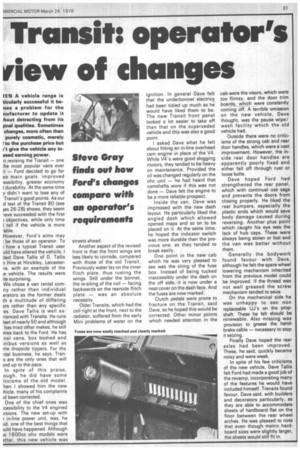Transit: operator's view of changes
Page 21

If you've noticed an error in this article please click here to report it so we can fix it.
IEN A vehicle range is ticularly successful it belies a problem for the nufacturer to update it :hout detracting from its jinal qualities. Sometimes changes, more often than purely cosmetic, merely I to the purchase pricebut i't give the vehicle any inused earning power.
n revising the Transit — one :he most popular vans ever it — Ford decided to go for ee main goals improved essibility, greater economy I durability. At the same time y didn't want to lose any of Transit's good points As our d test of the Transit 80 (see )es 26-28) shows, they seem lave succeeded with the first ) objectives, while only time I tell if the vehicle is more -able.
However, Ford's aims may
be those of an operator. To ; how a typical Transit user uld have altered the vehicle, I ited Dave Tallis of D. Tallis n Hire at Hinckley, Leicesterre, with an example of the N vehicle. The results were ite surprising.
We chose a van rental comny rather than individual erators as the former deals th a multitude of differing ars rather than any specific es. Dave Tallis is well exrienced with Transits. He runs leet of nearly 50 and although has tried other makes, he still mes back to the Ford, He has nel vans, box bodied and inibus versions as well as me dropside tippers. For the mai business, he says, Trans are the only ones that will 3n d up to the pace.
In spite of this praise, ough, he did have some iticisms of the old model. hen I showed him the new ;hide, many of his complaints id been corrected.
One of the chief ones was :cessibility to the V4 engined ;rsions. The new set-up with ) in-line power unit, was, he lid, one of the best tnings that )uld have happened. Although 1600cc an/ models were atter, this new vehicle was streets ahead.
Another aspect of the revised front is that the front wings are less likely to corrode, compared with those of the old Transit. Previously water lay on the inner flitch plate, thus rusting the wings. Still under the bonnet, the re-siting of the coil — facing backwards on the rearside flitch plate — was an absolute necessity.
Older Transits, which had the coil right at the front, next to the radiator, suffered from the early Mini problems of water on the ignition. In general Dave felt that the underbonnet electrics had been tidied up much as he would have liked them to be. The new Transit front panel looked a lot easier to take off than that on the superseded vehicle and this was also a good point.
I asked Dave what he felt about fitting an in-line overhead cam engine in place of the V4. While V4's were good slogging motors, they tended to be heavy on maintenance. Provided the oil was changed regularly on the ohc unit — he had heard that camshafts wore if this was not done — Dave felt the engine to be a more reliable prospect.
Inside the van, Dave was impressed with the new dash layout. He particularly liked the angled dash which allowed opened maps and so on to be placed on it. At the same time, he hoped the indicator switch was more durable than the previous one, as they tended to break easily.
One point in the new cab which he was very pleased to see was the siting of the fuse box. Instead of being tucked inaccessibly under the dash on the off side, it is now under a neat cover on the dash face. And the fuses are now marked.
Clutch pedals were prone to fracture on the Transit, said Dave, so he hoped this would be corrected. Other minor points which needed attention in the
cab were the visors, which were too flimsy, and the door trim boards, which were constantly coming off. A terrible omission on the new vehicle, Dave thought, was the pause wipe/ wash facility which the old vehicle had.
Outside there were no criticisms of the strong cab and rear door handles, which were a vast improvement. However, the inside rear door handles are apparently poorly fixed and either fall off through rust or loose bolts.
Dave hoped Ford had strengthened the rear panel, which with continual use sags and prevents the doors from closing properly. He liked the rear bumpers, especially the plastic ends which would save body damage caused during reversing. Another plus point which caught his eye was the lack of hub caps. These were always being stolen or lost and the van was better without them.
Generally the bodywork found favour with Dave, although he felt the spare wheel lowering mechanism inherited from the previous model could be improved. If the thread was not well greased the screw mechanism tended to seize.
On the mechanical side he was unhappy to see non replaceable UJ's on the propshaft. These he felt should be renewable. Also missing was provision to grease the handbrake cable — necessary to stop it seizing.
Finally Dave hoped the rear axles had been improved. These, he said, quickly became noisy and were weak.
In spite of his few criticisms of the new vehicle, Dave Tallis felt Ford had made a good job of the revamp, incorporating many of the features he would have included himself. Transits found favour, Dave said, with builders and decorators particularly, as they are able to accommodate sheets of hardboard flat on the floor between the rear wheel arches. He was pleased to note that even though metric hardboard sizes were slightly larger, the sheets would still fit in.
















































































